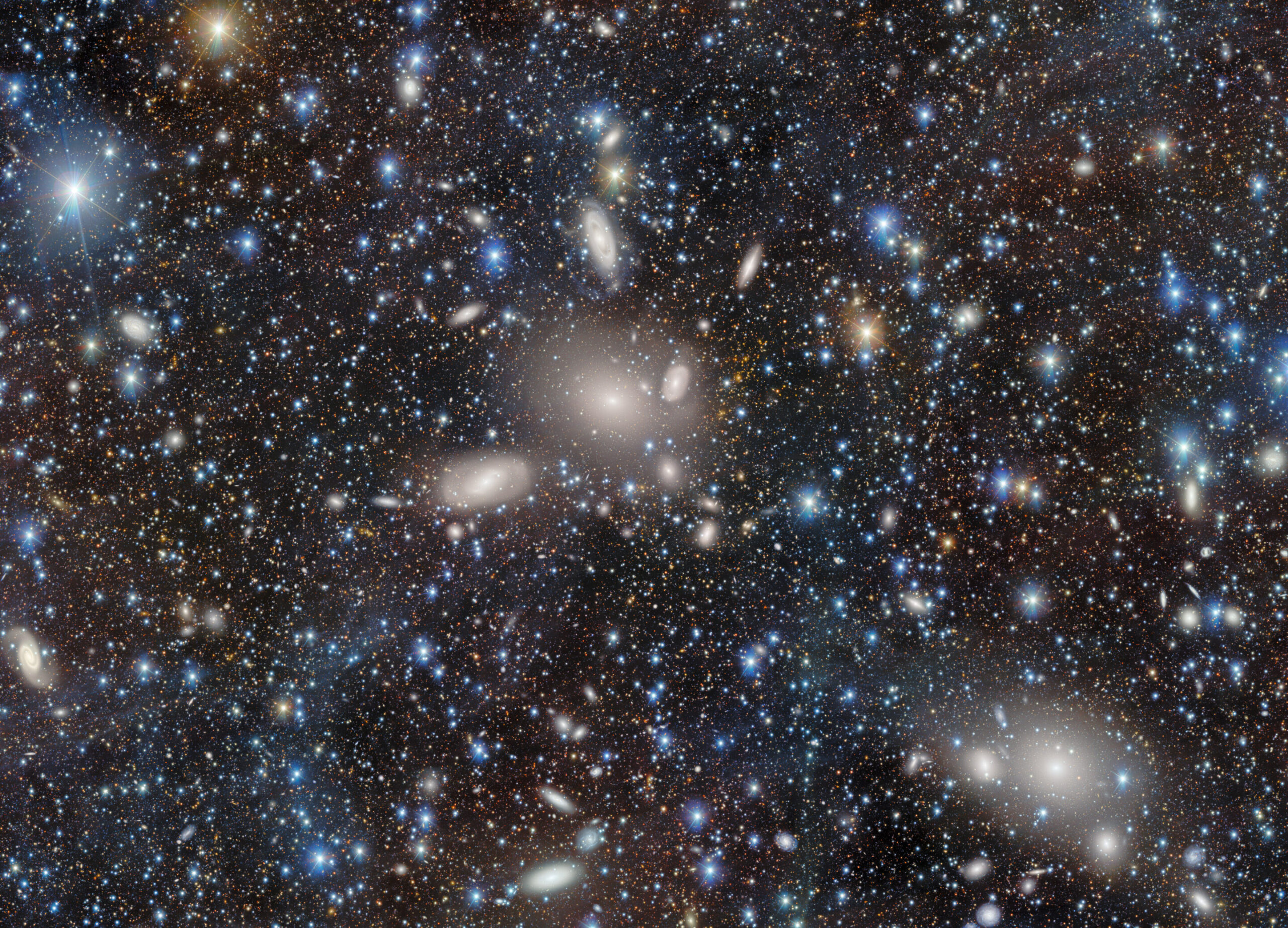NSF NOIRLab heralded the New Year with a breathtakingly detailed image of the Antlia Cluster, captured using the powerful Dark Energy Camera (DECam). This advanced instrument, constructed by the Department of Energy, is mounted on the U.S. National Science Foundation Víctor M. Blanco 4-meter Telescope at Cerro Tololo Inter-American Observatory in Chile. As part of NSF NOIRLab’s programs, this vivid portrait reveals a spectacular range of galaxy types nestled within one of the most captivating galaxy clusters in the local universe.
Galaxy clusters, vast cosmic assemblies comprising hundreds to thousands of galaxies, are among the largest structures in the known universe. Modern astrophysical models suggest that these colossal formations originate as clumps of dark matter, whose gravitational pull aggregates surrounding matter and galaxies. Over billions of years, smaller galactic groups merge, coalesce, and grow, eventually forming the sprawling structures astronomers study today.
One such cluster is the Antlia Cluster (Abell S636). Located approximately 130 million light-years from Earth, the Antlia Cluster lies in the southern constellation Antlia, also known as “The Air Pump.” Its relative proximity to our planet makes it an accessible target for observing the mechanisms behind galaxy evolution, merging, and interactions on cosmic scales.

Astronomers have been observing the Antlia Cluster for decades, and the detailed investigations represent a testament to the synergy of observational tools. Chile’s premier telescopes, including the Víctor M. Blanco Telescope equipped with the earlier MOSAIC II camera, and the Gemini South Telescope—a segment of NSF NOIRLab’s International Gemini Observatory—played a central role in these efforts. A long-term initiative known as the Antlia Cluster Project has studied its intricate galactic structure and evolution for more than 20 years. Complementary data from space-based observatories have expanded these investigations, culminating in a clearer understanding of the cluster’s extraordinary composition.
The Antlia Cluster is dominated by two colossal elliptical galaxies, NGC 3268 and NGC 3258, which anchor the cluster’s gravitational well. These massive galaxies are surrounded by numerous faint dwarf galaxies, some of which are rare or unusual types. Notably, X-ray observations reveal a “rope” of globular clusters between these two giants—strong evidence suggesting that the Antlia Cluster may represent two smaller galaxy clusters in the process of merging. Such mergers, among the most dramatic events in cosmic evolution, offer an unparalleled opportunity to study the dynamic processes at work in cluster formation.
A distinguishing feature of the Antlia Cluster is its abundance of lenticular galaxies. Lenticular galaxies possess disk-like structures similar to spiral galaxies, yet lack significant interstellar matter and ongoing star formation. This deficiency often renders them faint and difficult to detect, emphasizing the need for high-sensitivity instruments like DECam. Additionally, irregular galaxies—chaotic systems lacking distinct shapes—populate the cluster. Rare subtypes of faint dwarf galaxies have also been observed, such as ultra-compact dwarfs, compact ellipticals, and blue compact dwarfs. Researchers hypothesize that Antlia may harbor other elusive types like dwarf spheroidal galaxies and ultra-diffuse galaxies, though these remain subject to future verification.
Many of these rare galaxy types have only been classified in recent decades due to advances in telescopic and data analysis technologies. Improved sensitivity enables astronomers to detect galaxies with exceptionally low luminosity and relatively diminutive sizes, advancing the frontier of extragalactic astronomy. Detailed categorization of galaxies within clusters like Antlia contributes crucial data to models of galaxy evolution, allowing astronomers to map how different morphological types interact, form, and decay over time.
The cluster’s structural complexity extends beyond individual galaxies. Within its core lies diffuse intracluster light, a faint, ghostly glow produced by stars gravitationally ejected from galaxies during their interactions. This enigmatic light provides astronomers with a wealth of information about the cluster’s history, offering a glimpse into past mergers and tidal disruptions. Adding to the spectacle, Antlia’s diffuse light overlaps with remnants of the nearby Antlia Supernova Remnant, discovered in 2002.
Advanced observational technology, such as DECam, has unlocked new vistas in galaxy cluster studies. DECam is a marvel of modern astrophysics, capable of capturing fainter, more subtle features than its predecessors. By unveiling fine details within clusters, including tenuous streams of intracluster light, this instrument helps decode the distribution and dynamics of dark matter—a substance that accounts for about 25% of the universe’s total mass-energy composition yet remains invisible to conventional observations.
Dark matter’s pervasive influence plays a defining role in galaxy cluster formation and dynamics. Its gravitational effects sculpt the large-scale structure of the universe, yet its nature remains one of cosmology’s greatest mysteries. By mapping the interaction between dark matter and visible matter in clusters like Antlia, astronomers can better constrain theoretical models of dark matter and its interaction with baryonic (ordinary) matter.
Looking ahead, the upcoming NSF–DOE Vera C. Rubin Observatory and its Legacy Survey of Space and Time (LSST) promise transformative advancements in our understanding of galaxy clusters. The LSST will systematically map thousands of galaxy clusters with unprecedented detail, enabling astronomers to detect intracluster light across a diverse range of environments. This massive data set is expected to yield critical insights into the role of dark matter in cluster dynamics and the large-scale evolution of the universe.
The Antlia Cluster exemplifies the complexity and diversity of galaxy systems, providing a natural laboratory for studying the forces shaping cosmic architecture. Its dynamic features—from merging giants to faint dwarfs and diffuse stellar streams—showcase the evolutionary processes driving cosmic transformation. Observations of this remarkable cluster highlight the symbiotic relationship between cutting-edge technology and human curiosity, continuously deepening our understanding of the universe. As instruments like DECam and the Vera C. Rubin Observatory come online, these glimpses into the vast, interwoven tapestry of galaxies remind us of the infinite wonders lying just beyond our gaze.
Think this is important? Spread the knowledge! Share now.
